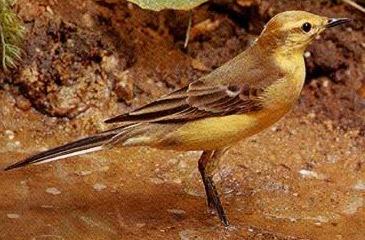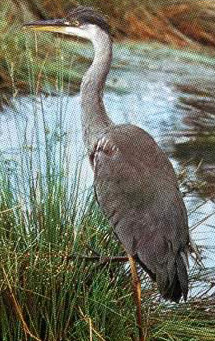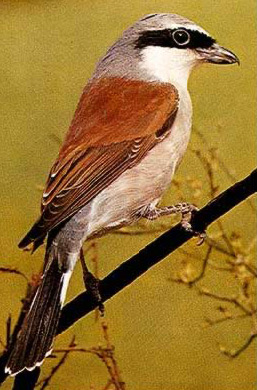
Major Birding Areas in Egypt

Historical travel represents a very old tradition in Egypt. People have been "touring" Egypt's historical sites actually since ancient times. However, there is another very traditional type of travel to Egypt. For certainly the past 150 years, people have been visiting Egypt to bird watch, and with Egypt's expanding national park system, it is likely that this activity will become even more popular. You may contact our Travel Department for a customized birding tour.

Birds have played an important role in Egypt history, especially their ancient religion where some of the earliest and most important gods, such as Horus, were thought to manifest themselves in various birds. Even the earliest creation myths evolved around certain birds such as the Benu, which may have originally been fashioned from the yellow wagtail (Motacilla flava), but which later was depicted as a gray heron (ardea cinera). A primeval goose known as Gengen-Wer (the Great Honker) represented several gods in their creative aspects. Horus, of course, was manifested in the form of a hawk, while gods such as Thoth could be represented as an Ibis. Re, one of Egypt's most important gods throughout its ancient history, was often represented with a falcon head, as was Nemty, Montu, Sokar, and Sopdu. There was also Nekhbet, a goddess represented in the form of a vulture. Many of these birds were, in fact, kept in sacred flocks by the ancient Egyptians and some individual birds were even elevated to temple animals. Even the souls (ba) of the ancient Egyptians were frequently depicted with the body a bird. Furthermore, the ancient Egyptians were superb natural historians and on the walls of their temples and tombs, over 76 different species of birds can be identified. Many of these depictions present hunts, which were sometimes symbolic. For example, scenes portraying the pharaoh netting wild fowl are said to symbolically represent the king taming the inimical spirits.
A number of habitats in Egypt are especially suitable for bird populations including, of course, the lush Nile River Valley, but others as well. There are about 150 resident breeding bird in Egypt. These resident birds of Egypt belong mainly to two zoogeographical regions consisting of Palaearctic and Ethiopian. They are mostly song and water birds confined to the Nile Valley, the Delta and to some of the western Oases.

However, more importantly, Egypt is a migration corridor which attracts some 280 additional species of birds. Egypt occupies a unique geographical location as a bridge between the continents of Europe, Asia and Africa and therefore millions of birds pass through the country on their way from Scandinavia, Eastern Europe, the Balkens, Siberia and Central Asia to eastern and southern Africa each autumn, and on their way back each spring.

Migration begins in the Winter months, when from about mid February, the first wave of storks and raptors can be seen. Summer migration begins in early August when water bird migration begins at Zaranik in North Sinai and White Stork migration begins in the southern Gulf of Suez.
Traditionally, there are a number of areas that are well suited for bird spotting in Egypt. Some more exotic locations, such as Lake Burullus, may however require special permits to visit.
Lake Burullus is located in the Nile Delta and is surrounded by marshes making it an important winter area for Wigeons, Shovellers, Pochards, Boots and Whiskered Terns. The good news is that, though it may be more difficult to visit, for this reason it is also very rewarding to do so.
Lake Manzala is being reclaimed for agricultural land, but it continues to offer opportunities for spotting Shelducks, Shovellers and Coots during the winter. There are also a number of shorebirds such as the Avocets.

The Grey Heron is a common year round resident in lagoons and marshes within the Delta

An Eagle Owl photographed in the area of Lake Nasser

Lake Bardawil on the northern coast of the Sinai has traditionally been one of Egypt's most famous bird watching regions. Located near Al-Arish, the lake is on a very important migration route, particularly for water birds. Visiting this site during the fall migration season may yield very interesting results. Here one finds herons and ducks (particularly Garganeys) as they pass through by the thousands, as do shorebirds such as Sanderlings, Little Stints, Dunlins and Avocets. Flamingos are relatively common on both Lake Bardawil and Lake Malaha.
Wadi Natrun, during ancient times, was a source of salt for Egypt's inhabitants but beginning with the Christian period, it was populated with some of the most famous of Egypt's Christian monasteries, which remain there to this day. Located along the desert road that connects Cairo with Alexandria, there are a number of lakes and marshes that team with bird life.
Here, one may find Kittlitz's Sandplover together with a number of migrant and wintering water birds. The farmland also attracts many birds including Blue-cheeked Bee-eaters and Rufous Bushchats.

Cairo itself offers many bird watching opportunities. Most visitors to Egypt land in the capital, where the Giza zoo offers both caged birds and others in its gardens. Many songbirds can be found here during the migratory seasons, and breeding birds include Nile Valley Sunbirds and Cattle Egrets. Senegal Thick-knees occupy the roofs of the city and not exactly on the tourists beaten path are the sewage treatment plants The Gebel Asfar treatment plant near the international airport offers waders and somewhat rare Painted Snipe, White-breasted Kingfishers and Egyptian Nightjar.
Suez sits at the southern end of the Suez canal, offering both a visit to that historical construct, as well as great bird watching. In fact, it is located at one of the most important concentration points for migratory birds of prey. Also, the mudflats are frequented by a vast number of migrating shorebirds. In the bay, various species of gulls and terns are numerous. Other occasional visitors include White-eyed Gulls and Lesser Crested Terns. Just south of Suez is Ain Sukhna,

a growing tourist community where Raptors can be seen migrating along the Galala Plateau. Passerines and near passerines occur in the coastal gardens and scrubs, while seabirds can also be seen, including Red Sea specialties, White-eyed Gulls and Swift Terns.
The Fayoum was once well known for bird hunting, but that this is apparently now rare. This large Oasis which includes Lake Qarun is excellent for bird watching and is important as a wintering ground for Grebes, ducks, coots and shorebirds.
Ras Muhammed, located at the southern tip of the Sinai just south of Sharm el-Sheikh, is both one of Egypt's best known and oldest protected areas, better known for its coral reefs than for its birds. However, this is a nesting ground for Osprey and Sooty Falcons, while White Storks pass overhead by the thousands during the fall. Herons and shorebirds are abundant here, and the nearby Isle ofTiran is an important breeding ground for Osprey, gulls and terns.

All along the Red Sea mainland coast of Egypt are islands that are inhabited by seabirds indigenous to the area such as White-eyed Gulls and White-cheeked Terns. Many can be seen from the coast. Luxor (ancient Thebes) is a primary tourist attraction for its great temples and tombs, but it is also an excellent location to view typical birds found in the Nile Valley. Here, one finds Purple Gallinule, Senegal Thick-knee, Nile Valley Sunbirds and even the rare Painted Snipe.
Aswan, another common tourist destination, offers exceptional bird spotting. A small sailboat ride (on a felucca) is often part of tour itineraries at Aswan, and may very well provide the opportunity to spot a Green Heron in addition to other breeding and migratory water birds such

as the Egyptian Goose. Black Kite circle the western bank of the Nile, and amongst them one may also spot a Lappet-faced or an Egyptian Vulture. (See also our feature story on the Bird Man of Aswan.)
Abu Simbel is the location of one of Egypt's icon temples built by Ramesses the Great (along with the smaller temple of his Great Queen Nefertari). Many African bird species may be found here along the shores of Lake Nasser, including Pink-backed Pelicans, Yellow-billed Storks, African Skimmers, Pink-headed Doves and African Pied Wagtails.
Gebel Elba is situated at the extreme southeastern corner of Egypt and offers a unique landscape differing from the remainder of the country. It provides a taste of subsaharan African birds including Ostriches, Verreaux's Eagles, Pink-headed Doves and Rosypatched Shrikes. This area has traditionally been difficult to reach, but with its elevation to a national protected area, and the Egyptian Government desires to promote these parks, since it is becoming more accessible.
We must note that there are a few individuals who have been instrumental in promoting Egyptian birding. Much of the research for this article comes from the book, Common Birds of Egypt by Bertel Bruun and Sherif Baha el Din. We note that this book is apparently not readily available, at least outside Egypt, at this time, though it can be reasonably attained from various used book dealers through Amazon.com

See Also:
Resources:
|
Title |
Author |
Date |
Publisher |
Reference Number |
|
Common Birds of Egypt |
Brunn, Bertel, el Din, Sherif Baha |
1994 |
American University in Cairo Press, The |
ISBN 977-424-239-4 |
|
Complete Gods and Goddesses of Ancient Egypt, The |
Wilkinson, Richard H. |
2003 |
Thames & Hudson, LTD |
ISBN 0-500-05120-8 |
|
Dictionary of Ancient Egypt, The |
Shaw, Ian; Nicholson, Paul |
1995 |
Harry N. Abrams, Inc., Publishers |
ISBN 0-8109-3225-3 |
|
Natural Selections (A Year of Egypt's Wildlife) |
Hoath, Richard |
1992 |
American University in Cairo Press, The |
ISBN 977-424-281-5 |
|
2001 |
Friedman/Fairfax |
ISBN 1-5866-3295-7 |
Last Updated: August 21st, 2011

